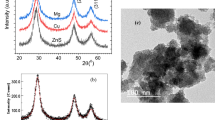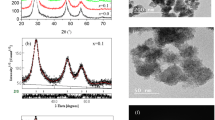Abstract
Zn0.75Cd0.25Sx (x = 1, 0.9, 0.8, 0.7, 0.6, 0.5) quantum dots were produced via thermolysis method. The structure and microstructures behaviors of Zn0.75Cd0.25Sx were examined using Rietveld refinement for the X-ray diffraction (XRD) data. A portion of the integrated O binds with Zn to create a segregated ZnO phase beside ZnS phase. The threshold sulfur deficiency with some O content incorporation into the Zn0.75Cd0.25Sx lattice without generating a new phase (ZnO) is x = 0.6. Zinc sulfide is the predominant phase, while the percentage of ZnO rises with increasing S deficiency (x). Zn0.75Cd0.25S0.8 has homogeneous spherical particle morphology with a very small size 2–4 nm, consistent with the XRD value. Zn0.75Cd0.25S0.8 has a homogeneous spherical particle morphology with very small size of 2–4 nm. The disorder’s characteristics and defects were examined through Urbach energy analysis. The optical dielectric constant, optical conductivity and nonlinear optical parameters were calculated for all samples. The optical band gap lowers as the sulfur content increases up to x = 0.6, eventually reaching 2.71 eV. With a reduction in sulfur content to x = 0.5, two optical band gaps (2.8, 3.16) eV were obtained. The refractive index (n) values obtained using different models for all samples. As the molar ratio (x) of Zn/Cd to S increased, the PL emission peak of Zn0.75Cd0.25Sx nanoparticles exhibited a Stokes shift caused by S vacancies. The emitted colors from each samples were obtained by using Gaussian fitting for PL spectra. The fluorescence intensity greatly increased by increasing the S deficiency reaching its maximum value at x = 0.6.










Similar content being viewed by others
Data availability
Data will be available on request.
References
Z.K. Heiba, M.B. Mohamed, M. Abdellatief, A.A. Alkathiri, S.I. Ahmed, Optical and magnetic studies of Y-Doped Nano γ-Fe2O3. J. Inorg. Organomet. Polym Mater. 32(10), 826 (2022)
G. Wang, B. Huang, Z. Li, Synthesis and characterization of ZnS with controlled amount of S vacancies for Photocatalytic H2 production under visible light. Sci. Rep. 5, 8544 (2015)
J.-S. Hu, L.-L. Ren, Y.-G. Guo, H.-P. Liang, A.-M. Cao, L.-J.W. Prof, Dr., C-L Bai Prof. Dr. Mass production and high photocatalytic activity of ZnS Nanoporous nanoparticles. Angew Chem. Int. Ed. 44, 1269 (2005)
J. Zhang, J. Yu, Y. Zhang, Q. Li, J.R. Gong, Visible light Photocatalytic H2-Production activity of CuS/ZnS porous nanosheets based on Photoinduced Interfacial Charge transfer. Nano Lett. 11, 4774 (2011)
X. Hao, Y. Wang, Z. JZhou, Y. Cui, Z. Wang, Zou, Zinc vacancy-promoted photocatalytic activity and photostability of ZnS for efficient visible-light-driven hydrogen evolution. Appl. Catal. B 221, 302 (2018)
S. Suganya, M. Jothibas, S. Johnson, Jeyakumar, Solid state synthesis of cadmium doped ZnS with excellent photocatalytic activity and enhanced visible light emission. J. Mater. Sci: Mater. Electron. 30, 7916 (2019)
D. Maarisetty, S.S. Baral, Effect of defects on Optical, Electronic, and Interface properties of NiO/SnO2 heterostructures: dual-functional solar Photocatalytic H2 Production and RhB Degradation. ACS Appl. Mater. Interfaces, 13 (50)(2921) 60002
Surface defect engineering of mesoporous Cu/, ZnS nanocrystal-linked networks for improved visible-light photocatalytic hydrogen production
X. Zhou, Q. Yang, H. Wang, F. Huang, J. Zhang, S. Xu, Influences of reaction temperature, holding time and S/Zn molar ratio on structure, morphology, optical and electrical properties of ZnS nanoparticles synthesized by hydrothermal method. J. Mater. Sci: Mater. Electron. 30, 1089 (2019)
C. Du, Q. Zhang, Z. Lin, B. Yan, C. **a, G. Yang, Half-unit-cell ZnIn2S4 monolayer with sulfur vacancies for photocatalytic hydrogen evolution. Appl. Catal. B 248, 193 (2019)
X. Hao, Z. Cui, J. Zhou, Y. Wang, Y. Hu, Y. Wang, Z. Zou, Architecture of high efficient zinc vacancy mediated Z-scheme photocatalyst from metal-organic frameworks. Nano Energy. 52, 105 (2018)
G. Wang, B. Huang, Z. Li, Z. Lou, Z. Wang, Y. Dai, M.-H. Whangbo, Synthesis and characterization of ZnS with controlled amount of S vacancies for Photocatalytic H2 production under visible light. Sci. Rep. 5, 8544 (2015)
F.-P. Yu, S.-L. Ou, P.-C. Yao, B.-R. Wu, D.-S. Wuu, Volume, Structural, surface morphology and Optical properties of ZnS films by Chemical Bath Deposition at various Zn/S molar ratios. J. Nanomaterials, 2014, Article ID 594952, 7 pages.
E.M. Jubeer, M.A. Manthrammel, P.A. Subha, M. Shkir, K.P. Biju, S.A. AlFaify, Defect engineering for enhanced optical and photocatalytic properties of ZnS nanoparticles synthesized by hydrothermal method. Sci. Rep. 13, 16820 (2023)
X. Wang, J. Shi, Z. Feng, M. Lia, C. Li, Visible emission characteristics from different defects of ZnS nanocrystals. Phys. Chem. Chem. Phys. 13, 4715 (2011)
J. Tauc, Amorphous and Liquid Semiconductors (Springer, Boston, 1974)
S.A.M. Issa, H.M.H. Zakaly, H.O. Tekin, H.A. Saudi, A. Badawi, M. Pyshkina, G. Susoy, A.I. Elazaka, A. Ene, Exploring the FTIR, optical and nuclear radiation shielding properties of samarium-borate glass: a characterization through experimental and simulation methods. Nanomaterials. 11(7), 1713 (2021)
M. Dekkers, G. Rijnders, D.H.A. Blank, ZnIr2O4, a p-type transparent oxide semiconductor in the class of spinel zinc-d6-transition metal oxide. Appl. Phys. Lett. 90, 021903 (2007)
T.S. Moss, Photoconductivity in the Elements. Proceedings of the Physical Society. Section A 64 6
N.M. Ftavindfta, S. Auluck, V.K. Srivastava, On the Perm Gap in Semiconductors. phys. stat. sol (b), 93 (1979) kl55
A. Bahadur, M. Mishra, Correlation between refractive index and electronegativity difference for AN B8-N type binary semiconductors. Acta Phys. Pol. A 123(4), 737 (2013)
P. Herve, L.K.J. Vandamme, General relation between refractive index and energy gap in semiconductors. Infrared Phys. Technol. 35(4), 609 (1994)
T.S. Moss, Relations between the Refractive Index and Energy Gap of Semiconductors. phys. stat. sol (b) 131 (1985) 415
M. Anani, C. Mathieu, S. Lebid, Y. Amar, Z. Chama, H. Abid, Model for calculating the refractive index of a III–V semiconductor. Comput. Mater. Sci. 41, 570 (2008)
V. Kumar, J.K. Singh, Model for calculating the refractive index of different materials. Indian J. Pure Appl. Phys. 48, 571 (2010)
Z.K. Heiba, X-ray structural phase analysis of CdTe semiconductor annealed in air. Cryst. Res. Technol. 38(6), 488 (2003)
Z.K. Heiba, X-ray quantitative analysis of the phases developed upon air annealing of ZnSe, CdSe, and CdS semiconductors. Powder Diffr. 17(3), 191 (2002)
C. Anthonyraj, M. Muneeswaran, S. Gokul Raj, N.V. Giridharan, V. Sivakumar, G. Senguttuvan, Effect of samarium do** on the structural, optical and magnetic properties of solgel processed BiFeO3 thin films. J. Mater. Sci: Mater. Electron. 26, 49 (2015)
A.M. El Nahrawy, A.S. Montaser, A.M. Bakr, A.B.A. Hammad, A.M. Mansour, Impact of ZnO on the spectroscopic, mechanical, and UPF properties of Fe2O3-tough polystyrene-based nanocomposites. J. Mater. Science: Mater. Electron. Volume. 32, 28019 (2021)
K. Zein, A.A. Heiba, Albassam & Mohamed Bakr Mohamed, Effect of Zn/S non–stoichiometric ratio on the structural, optical and electronic properties of nano–ZnS. Appl. Phys. A 126, 479 (2020)
S. Locmelis, C. Brunig, M. Binnewies, A. Borger, K.D. Becker, T. Homann, T. Bredow, Optical band gap in the system ZnO1-xSx, An experimental and quantum chemical study, J Mater Sci. 42 (2007)1965
A.A.A. Ahmed, E.A.A. Alahsab, A.M. Abdulwahab, The influence of zn and mg do** on the structural and optical properties of NiO nano-structures for optoelectronic applications. Results Phys. 22, 103938 (2021)
S.H. Mohamed, R. Drese, Structural and optical properties of direct current sputtered zinc aluminum oxides with a high Al concentration. Thin Solid Films. 513, 64 (2006)
A.M. Bolbol, H. Elshimy, O.H. Abd-Elkader, M. Kamel, S.A. Shata, N.Y. Mostafa, Impact of Sb-insertion on structural, optical, and dielectric characteristics of the PbI2 thin film. Opt. Mater. 134, 113180 (2022)
G.R. Suma, N.K. Subramani, K.N. Shilpa, S. Sachhidananda, S.V. Satyanarayana, Siddaramaiah, Effect of Ce0.5Zr0.5O2 nano fillers on structural and optical behaviors of poly(vinyl alcohol). J. Mater. Sci.: Mater. Electron. 28(14), 10707 (2017)
A.R. Abdullah, M.Y. El-Ashry, E.-S.M. Duraia, W.E. Mahmoud, The do** effect on the linear and nonlinear optical behaviors of nickel oxide films for multiple optoelectronic applications. Micro Nanostruct. 188, 207785 (2024)
Z. **, Y. Liu, X. Hao, Self-assembly of zinc cadmium sulfide nanorods into nanoflowers with enhanced photocatalytic hydrogen production activity. J. Colloid Interface Sci. 567, 357 (2020)
S. Qi, Y. Miao, J. Chen, H. Chu, B. Tian, B. Wu, Y. Li, B. **n, Controlled Biosynthesis of ZnCdS Quantum Dots with Visible-Light -Driven Photocatalytic Hydrogen Production Activity, vol. 11 (Nanomaterials, 2021), p. 1357
X. Zhang, Z. Zhao, W. Zhang, G. Zhang, D. Qu, X. Miao, S. Sun, Z. Sun, Surface defects enhanced visible light Photocatalytic H2 production for Zn-Cd-S solid solution. Small. 12, 793 (2016)
L. Canham, Introductory lecture: origins and applications of efficient visible photoluminescence from silicon-based nanostructures. Faraday Discuss. 222, 10 (2020)
Acknowledgements
The authors extend their appreciation to Taif University, Saudi Arabia, for supporting this work through project number (TU-DSPP-2024-44).
Funding
This research was funded by Taif University, Saudi Arabia, Project No. (TU-DSPP-2024-44).
Author information
Authors and Affiliations
Contributions
All authors contributed equally to carrying out the present study. They wrote, read and approved the final manuscript.
Corresponding authors
Ethics declarations
Competing interests
The authors report no declarations of interest.
Additional information
Publisher’s Note
Springer Nature remains neutral with regard to jurisdictional claims in published maps and institutional affiliations.
Rights and permissions
Springer Nature or its licensor (e.g. a society or other partner) holds exclusive rights to this article under a publishing agreement with the author(s) or other rightsholder(s); author self-archiving of the accepted manuscript version of this article is solely governed by the terms of such publishing agreement and applicable law.
About this article
Cite this article
Heiba, Z.K., Abozied, A.M., Badawi, A. et al. The impact of sulfur deficiency on the structural, optical and photoluminescence properties of Zn0.75Cd0.25S quantum dots. Appl. Phys. A 130, 503 (2024). https://doi.org/10.1007/s00339-024-07667-5
Received:
Accepted:
Published:
DOI: https://doi.org/10.1007/s00339-024-07667-5




